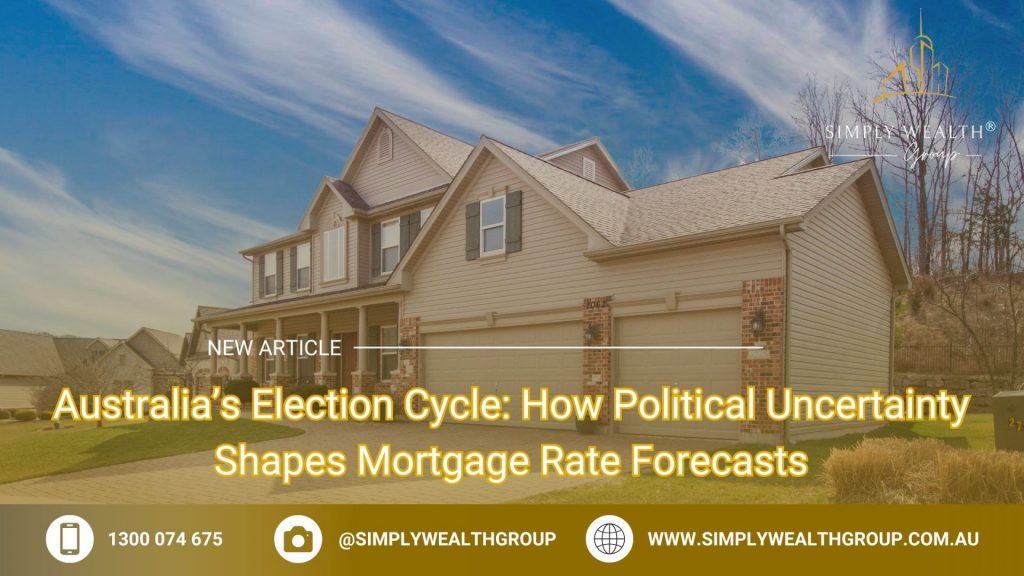RBA’s Surprise Rate Pause: What It Means for Borrowers and the Property Market

RBA’s Surprise Rate Pause: What It Means for Borrowers and the Property Market The RBA’s surprise rate pause at 3.85% in July 2025 caught markets and economists off guard. Many expected the Reserve Bank of Australia to cut rates as inflation slowed, but the central bank decided to hold steady, creating mixed reactions across the economy and property market. Why the RBA Held Rates The decision reflects the RBA’s cautious stance toward lingering inflation and steady job growth.While consumer prices have eased, services inflation in areas such as housing, insurance, and health remains sticky. The RBA stated that inflation is trending lower but is still above its target range. In short, the pause means the RBA prefers to wait and assess economic data before making any cuts. Impact on the Property Market The RBA’s Surprise Rate Pause has also affected the Australian property market.Buyer confidence has slightly improved as the decision signals economic stability. Property prices in major cities like Sydney and Melbourne are likely to stabilise as the market adjusts to this steady rate environment. Key takeaways for property: Home prices may hold firm through the remainder of 2025. Investors could re-enter the market to benefit from strong rental yields. First-home buyers gain clarity for financial planning. Without an immediate rate cut, affordability pressures will remain, but the RBA’s Surprise Rate Pause offers much-needed certainty to the housing market. Impact on the Property Market The Australian property market is already responding to the RBA’s decision.Confidence among buyers and investors has improved slightly since the announcement, as the pause signals that the economy is stable rather than weakening. Key takeaways for property: Home prices in major cities like Sydney and Melbourne may stabilize. Investors are likely to re-enter the market with rental yields staying strong. First-home buyers now have more certainty when planning their purchases. However, analysts warn that affordability challenges will continue without a rate cut, especially for those already struggling with higher living costs. Outlook for the Rest of 2025 Analysts believe the RBA’s Surprise Rate Pause may be temporary. Markets expect the Reserve Bank of Australia to begin rate cuts later in 2025 if inflation continues to fall. A gradual easing cycle could boost property activity heading into 2026. For now, the RBA’s Surprise Rate Pause represents a period of stability before stimulus. Borrowers and investors should take advantage of this time to reassess their financial strategies and prepare for future opportunities. Final Thoughts The RBA’s Surprise Rate Pause at 3.85% shows the central bank’s commitment to balancing inflation control and economic growth.While rates are steady for now, both borrowers and property investors can use this period to plan ahead and strengthen their positions before the next policy move.
Post-Election Property Landscape: New Opportunities for Australian Investors

Post-Election Property Landscape: New Opportunities for Australian Investors In the week following Labor’s decisive May 3, 2025, election victory, auction clearance rates in Melbourne surged to 74.4%—the highest in two years—while buyer inquiries spiked by 30% on Sunday alone, according to BresicWhitney CEO Thomas McGlynn. This immediate market response underscores the profound impact of political stability on investor confidence, particularly as the Reserve Bank of Australia prepares for a widely anticipated rate cut on May 20. Yet, beneath the surface of this apparent optimism lies a more intricate dynamic. Supply constraints remain acute, with Western Sydney producing just 22.5% of its annual housing needs, a shortfall mirrored across other high-demand regions. Analysts predict that Labor’s expansive housing policies, including the Help to Buy program, could drive property prices up by 8-15%—but only after a lag period that may leave early movers at a distinct advantage. This convergence of political clarity, fiscal policy shifts, and structural imbalances is reshaping Australia’s property market in ways that demand both urgency and strategic foresight. Image source: sbs.com.au Impact of Political Cycles on Real Estate Political cycles exert a nuanced influence on real estate, particularly through the interplay of policy clarity and market sentiment. While elections often introduce short-term volatility, the immediate aftermath of a decisive result can catalyze rapid shifts in investor behavior. This phenomenon is especially pronounced in regions with constrained supply, where even minor policy adjustments can amplify price dynamics. One critical mechanism is the reduction of transaction delays in response to political certainty. Research from Domain highlights that heightened policy uncertainty correlates with an 8.08% decline in property sales, yet this effect dissipates swiftly once electoral outcomes are resolved. For instance, following the 2019 federal election, market activity rebounded sharply as confidence in property stocks surged, underscoring the importance of clarity over prolonged ambiguity. However, the practical application of this insight reveals complexities. Investors must navigate the lag between policy announcements and tangible impacts, such as housing supply initiatives. As property strategist Arjun Paliwal notes, “The window between policy clarity and market adjustment is where strategic opportunities lie.” This dynamic underscores the need for a dual approach: leveraging immediate sentiment-driven opportunities while positioning for long-term structural shifts. By integrating these strategies, investors can mitigate risks and capitalize on the cyclical nature of political influence. Key Policy Changes Affecting Investors The introduction of the 5% deposit scheme and extended 40-year mortgage terms represents a transformative shift in property investment dynamics. While these policies are often celebrated for improving accessibility, their deeper implications for investors reveal a complex interplay of liquidity, risk, and long-term financial planning. By lowering entry barriers, these measures stimulate immediate demand, particularly in markets with constrained supply. However, the extended mortgage terms introduce a nuanced trade-off: reduced monthly repayments at the cost of significantly higher lifetime interest expenses. A comparative analysis highlights the strengths and weaknesses of these approaches. The 5% deposit scheme accelerates market entry, enabling investors to leverage capital more effectively. Yet, it also amplifies competition in lower price brackets, potentially inflating property values. Conversely, the 40-year mortgage term offers cash-flow advantages but may deter investors focused on maximizing equity growth due to prolonged debt servicing. Contextual factors, such as regional supply shortages and infrastructure development, further influence the effectiveness of these policies. For instance, areas with robust transport links and lifestyle appeal are likely to see heightened demand, intensifying price pressures. “These policies reshape not just affordability but the entire investment calculus, requiring a recalibration of strategies to balance short-term liquidity with long-term returns.” — Dr. Nicola Powell, Chief of Research, Domain This evolving landscape underscores the need for investors to adopt adaptive strategies that align with both immediate opportunities and enduring financial objectives. Analyzing Market Trends and Investor Sentiment Investor sentiment in Australia’s post-election property market reveals a dynamic interplay between macroeconomic signals and localized market conditions. A striking example is the 74.4% auction clearance rate recorded in Melbourne, which underscores the immediate impact of political stability on buyer confidence. This surge, however, is not uniform across regions. In Western Sydney, where housing production meets only 22.5% of annual demand, constrained supply continues to amplify price pressures, creating a stark contrast to more balanced markets. Quantitative shifts in interest rates further shape sentiment. The Reserve Bank of Australia’s anticipated rate cut on May 20 is expected to lower borrowing costs, with major lenders already offering variable rates below 5.75%. This preemptive adjustment has spurred urgency among investors, as reduced financing costs enhance purchasing power. However, the lag between rate cuts and their full economic impact highlights a critical window for strategic acquisitions. Investor behavior mirrors a “domino effect,” where macroeconomic changes trigger localized responses. For instance, infrastructure upgrades in growth corridors often magnify demand, creating ripple effects that extend beyond immediate urban centers. This nuanced relationship between policy, sentiment, and regional dynamics demands a sophisticated, data-driven approach to property investment. Image source: apimagazine.com.au Regional Variations in Property Demand Localized infrastructure development plays a pivotal role in shaping regional property demand, often overshadowing broader market trends. For instance, the Sunshine Coast in Queensland has experienced a surge in property interest following the completion of the $1.8 billion Bruce Highway upgrade. This project not only improved connectivity to Brisbane but also enhanced the region’s appeal for remote workers and lifestyle-driven buyers. Such targeted investments demonstrate how infrastructure can act as a catalyst for regional growth, creating pockets of high demand even in otherwise stable markets. A critical factor influencing these variations is the disparity in how quickly regions respond to policy changes. Areas like Newcastle, with established transport links and economic diversification, tend to see immediate price escalations following government incentives. In contrast, emerging suburbs with underdeveloped amenities often experience delayed reactions, as buyers wait for tangible improvements. This lag creates opportunities for investors willing to adopt a long-term perspective, capitalizing on undervalued properties before demand peaks. “Infrastructure projects are the linchpin of regional property growth, transforming accessibility into tangible value.” — Dr. Nicola Powell, Chief
Election 2025: Major Property Wins for Australian Homebuyers and Investors

Election 2025: Major Property Wins for Australian Homebuyers and Investors In March 2025, Sydney’s median property price surged past $1.5 million—a 12% increase in just 12 months, according to CoreLogic. Yet, as housing affordability reached crisis levels, political promises of relief flooded the federal election campaigns. Labor’s $10 billion Housing Australia Future Fund, aimed at constructing 30,000 affordable homes over five years, has drawn both praise and skepticism. Dr. Nicole Gurran, a housing policy expert at the University of Sydney, warns that “without zoning reform and streamlined approvals, these investments risk delays and cost blowouts.” Meanwhile, the Coalition’s proposal to allow first-home buyers to withdraw up to $50,000 from their superannuation for deposits has sparked debate. Critics, including Dr. Brendan Coates of the Grattan Institute, argue such demand-side measures inflate prices in already constrained markets. With over 30% of Australians experiencing housing stress, the stakes are immense. The election’s housing policies will shape not just affordability but the nation’s economic and social fabric. Image source: createvic.com.au Overview of Key Housing Policy Proposals One critical aspect of the 2025 housing policy landscape is the interplay between supply-side initiatives and the structural barriers that hinder their effectiveness. Labor’s ambitious target of delivering 1.2 million homes by 2029 under the National Housing Accord exemplifies this challenge. While the scale of the proposal is commendable, its success hinges on addressing entrenched zoning restrictions and approval delays. Without these reforms, even substantial financial investments risk being undermined by bureaucratic inertia. Comparatively, the Coalition’s focus on demand-side measures, such as the Super Home Buyer Scheme, highlights a contrasting approach. While this policy empowers first-home buyers by increasing deposit accessibility, it inadvertently exacerbates demand in markets already constrained by limited supply. Historical data from similar schemes in Canada reveals that such measures often lead to short-term price inflation, disproportionately benefiting higher-income earners. “Demand-side incentives without parallel supply-side reforms risk intensifying affordability challenges,”— Dr. Brendan Coates, Economic Policy Program Director, Grattan Institute A novel framework for evaluating these policies involves integrating financial literacy programs with housing initiatives. This ensures participants make informed decisions, aligning personal goals with market realities. Ultimately, the effectiveness of these proposals depends on harmonizing immediate relief with systemic reforms to foster long-term housing stability. Current Challenges in the Australian Housing Market A critical challenge in Australia’s housing market lies in the inefficiency of planning and zoning systems, which significantly delay housing supply expansion. These delays, often spanning years, create a bottleneck that disrupts the equilibrium between supply and demand, exacerbating affordability issues. The fragmented nature of zoning regulations across local councils further compounds this problem, as inconsistent standards hinder the timely approval of high-density projects in urban areas where demand is most acute. The economic implications of these delays are profound. For instance, research from the Urban Development Institute of Australia highlights that medium- and high-density projects frequently face approval timelines exceeding two years, inflating costs and deterring private investment. This inefficiency is particularly detrimental in a market already strained by labor shortages and rising material costs, which have pushed construction expenses to unprecedented levels. “Australia’s land-use planning rules are highly prescriptive and complex, creating systemic barriers to timely housing delivery,”— Dr. Brendan Coates, Economic Policy Program Director, Grattan Institute To address these challenges, a novel approach could involve integrating digital tools, such as AI-driven approval systems, to streamline zoning processes. By automating compliance checks and standardizing criteria across jurisdictions, these technologies could reduce delays and foster a more responsive housing supply pipeline. Party-Specific Housing Promises and Their Implications Labor’s housing strategy emphasizes large-scale supply initiatives, such as the construction of 100,000 cost-price homes over eight years, supported by a $10 billion Housing Australia Future Fund. While this approach aims to alleviate affordability pressures, execution challenges loom. For instance, the Australian Bureau of Statistics (ABS) reports a 20% increase in construction costs since 2022, driven by labor shortages and material price surges. Without addressing these systemic constraints, Labor’s ambitious targets risk significant delays and cost overruns, undermining their intended impact. In contrast, the Coalition’s policies focus on demand-side relief, including allowing first-home buyers to withdraw up to $50,000 from their superannuation for deposits. While this measure improves accessibility, historical data from Canada’s similar Home Buyers’ Plan reveals a 5-10% spike in property prices following its implementation, disproportionately benefiting sellers over buyers. This underscores the risk of exacerbating affordability issues in supply-constrained markets. Interestingly, both parties neglect zoning reform—a critical bottleneck. As Dr. Sarah Holden, a housing economist, notes, “Streamlined approvals could unlock 35,000 stalled projects nationwide, accelerating supply without additional funding.” This highlights the need for systemic reforms to complement headline-grabbing promises. Image source: matusik.com.au Labor’s Housing Targets and Incentives Labor’s ambitious housing targets hinge on the interplay between financial incentives and systemic reform, particularly in addressing restrictive zoning laws. A critical yet underexplored aspect is the integration of Transport-Oriented Development (TOD) principles into their housing strategy. By aligning new housing projects with existing transit infrastructure, TOD aims to reduce urban sprawl while enhancing accessibility. However, the success of this approach depends on overcoming entrenched planning inefficiencies. The mechanics of TOD reveal its potential and limitations. For instance, while TOD can significantly reduce commuting times and environmental impact, its implementation often faces delays due to fragmented governance and protracted rezoning processes. A case study from New South Wales highlights this challenge: a TOD initiative aimed at integrating housing with transit hubs faced a three-year delay due to local council resistance and inconsistent approval criteria. “Infrastructure funding works best when paired with streamlined planning processes and workforce initiatives.” — Dr. Julie Collins, Housing Policy Expert Labor’s $10 billion Housing Australia Future Fund could amplify TOD’s impact by prioritizing projects in high-demand urban corridors. However, without addressing labor shortages and material cost surges, these initiatives risk stagnation. A novel framework could involve leveraging AI-driven planning tools to standardize approval processes, ensuring that financial investments translate into timely, scalable housing solutions. This approach underscores the necessity of harmonizing policy ambition with practical execution. Coalition’s Tax Reforms
Australia’s First Home Buyer Boom: How Elections Influence Incentives

In 2022, Australian first-home buyers accounted for just 26% of new housing loans, a sharp decline from the 30-year average of 35%, according to the Australian Bureau of Statistics. Yet, in the lead-up to the 2025 federal election, both major political parties have unveiled aggressive policies aimed at reversing this trend. Labor’s promise to build 1.2 million homes by 2029 and expand shared-equity schemes with 5% deposit options stands in stark contrast to the Coalition’s plan to unlock 500,000 homes by reducing immigration and allowing first-home buyers to access $50,000 from their superannuation. However, experts like Steven Rowley, a property professor at Curtin University, warn that such measures often exacerbate affordability issues. “These policies are only going to increase demand, which will push up prices,” he notes. Historical data supports this: similar initiatives, such as the First Home Owner Boost in 2008, temporarily spiked home purchases but also inflated property values by 13.6% in major cities. This interplay between political strategy and market dynamics underscores a critical tension—election-driven incentives may offer short-term relief but risk entrenching long-term inequities in Australia’s housing market. Image source: realestate.com.au Historical Context of First Home Buyer Incentives The evolution of first home buyer (FHB) incentives in Australia highlights a critical interplay between economic cycles and policy design. Initially introduced as modest post-war measures, these programs aimed to stabilize housing access for young families. However, their role has since expanded, becoming tools for economic stimulus during downturns and politically strategic instruments during election cycles. This shift underscores a nuanced dynamic: incentives often reflect broader economic conditions rather than purely electoral motives. A key insight lies in the timing of these policies. Historical data reveals that incentives introduced during recovery phases, such as the 1980s adjustments, often triggered temporary surges in home purchases. Yet, these surges frequently led to unintended price inflation, particularly in lower-tier markets. This phenomenon challenges the assumption that such measures inherently improve affordability. “The real impact of FHB incentives lies not in their magnitude but in their timing and market context,” notes Michael McKenzie, a housing policy analyst. Comparative analysis with international counterparts, such as the UK’s time-limited stamp duty exemptions, further illustrates how targeted, temporary measures can mitigate distortions. These examples emphasize the importance of aligning policy design with market conditions, a principle often overlooked in domestic implementations. Understanding these temporal and contextual factors is essential for crafting effective, sustainable FHB policies. Political Strategies and Their Impact on Housing Election-driven housing policies often prioritize immediate voter appeal over structural market stability, a dynamic that significantly influences first-home buyer (FHB) behavior. A critical mechanism at play is the strategic timing of demand-side incentives, such as grants or tax deductions, which are frequently announced in the months leading up to elections. These measures create a perception of urgency, spurring short-term market activity but often exacerbating affordability challenges. The effectiveness of such strategies hinges on their alignment with market conditions. For example, when New South Wales expanded FHB incentives in 2023, auction activity in Sydney’s outer suburbs surged by 18% within three months. However, supply constraints, including restrictive zoning and labor shortages, muted the intended benefits, leaving prices elevated. This underscores a key limitation: demand-side policies amplify competition without addressing underlying supply bottlenecks. “Election-driven schemes tend to be stop-gap measures that only stimulate demand in a contained period, leaving fundamental supply issues unaddressed.” — Michael McKenzie, Property Economist A more sustainable approach would integrate supply-side reforms, such as streamlined planning approvals or inclusionary zoning policies. These measures, while politically less expedient, offer the potential to stabilize prices and improve long-term affordability, addressing systemic imbalances rather than perpetuating cyclical volatility. Mechanisms of First Home Buyer Incentives First-home buyer (FHB) incentives in Australia operate as finely tuned levers within the housing market, designed to influence buyer behavior and market dynamics. These mechanisms, while appearing straightforward, are deeply interwoven with economic and political strategies. For instance, the First Home Owner Grant (FHOG), introduced in 2000, provided up to $7,000 to eligible buyers. However, its impact extended beyond financial relief; studies reveal that 60% of recipients accelerated their purchase decisions, amplifying short-term demand. A critical yet underappreciated mechanism is stamp duty concessions, which reduce upfront costs for buyers. In Victoria, for example, FHBs purchasing properties under $600,000 are exempt from stamp duty, saving up to $31,000. This policy not only lowers entry barriers but also signals affordability, often driving competition in lower-tier markets. However, experts like Dr. Hal Pawson of UNSW argue that such measures disproportionately benefit higher-income buyers, inadvertently sidelining those most in need. These incentives, while politically expedient, often fail to address systemic supply constraints, underscoring the need for integrated reforms that balance demand stimulation with sustainable housing development. Image source: successfulways.com.au Understanding First Home Owner Grants and Schemes The First Home Owner Grant (FHOG) operates as a dual-purpose mechanism: reducing financial barriers for first-time buyers while indirectly influencing market dynamics. At its core, the grant offsets initial deposit requirements, enabling faster entry into homeownership. However, its broader implications reveal complexities that extend beyond its immediate financial relief. One critical dynamic is the grant’s interaction with market pricing. Research indicates that FHOGs often lead to localized price inflation, particularly in lower-tier markets where first-home buyers are most active. This occurs because the increased purchasing power intensifies competition for limited housing stock, driving up prices. A study by Wood et al. (2006) highlighted that many recipients would have purchased homes without the grant, suggesting its primary effect is to accelerate demand rather than expand access. Comparatively, jurisdictions like Western Australia, which offer reduced grants for established homes, demonstrate a nuanced approach. By incentivizing new construction over existing properties, these schemes aim to alleviate supply constraints. However, implementation challenges persist, such as ensuring adequate land availability and addressing labor shortages in the construction sector. “The FHOG’s untargeted nature often exacerbates affordability issues, particularly for low-income buyers,” notes Dr. Hal Pawson, housing policy expert at UNSW. Ultimately, while FHOGs provide short-term benefits, their long-term efficacy depends on integration with
Election Year Opportunities: Why Investors Target Australia’s Auction Markets

Election Year Opportunities: Why Investors Target Australia’s Auction Markets In May 2019, as Australians cast their votes in a tightly contested federal election, auction clearance rates in Sydney surged to 65%, defying the typical slowdown associated with political uncertainty. This counterintuitive trend, highlighted in Domain’s property market analysis, revealed a striking dynamic: while overall auction volumes halved, serious buyers capitalized on reduced competition, driving intense bidding wars. Election cycles, often seen as periods of hesitation, have repeatedly demonstrated their potential to reshape market behavior. Dr. Nicola Powell, Chief of Research and Economics at Domain, notes that “election-day auctions often outperform surrounding weekends, as committed buyers seize opportunities in quieter markets.” This phenomenon underscores the interplay between political sentiment and structural market forces, such as Sydney’s chronic housing supply shortage. With Australia’s Economic Policy Uncertainty Index spiking during elections, the property market becomes a microcosm of strategic decision-making—where volatility doesn’t deter activity but refines it. Image source: fastercapital.com The Mechanics of Property Auctions in Australia The intricate choreography of Australian property auctions reveals a dynamic interplay of strategy, psychology, and market forces. At its core, the auction process is a high-stakes negotiation where auctioneers act as both facilitators and tacticians, leveraging subtle cues to drive competitive bidding. This nuanced approach is particularly evident in the way auctioneers manage momentum, adjusting their cadence and tone to sustain engagement while gauging buyer intent. One critical technique is the strategic use of “vendor bids” to set a psychological anchor. By introducing a bid on behalf of the seller, auctioneers establish a baseline that encourages upward momentum. However, this approach requires precision; an overly aggressive vendor bid risks alienating participants, while a conservative one may fail to ignite competition. Comparative analysis of auctions in Sydney and Melbourne highlights this balance, with Sydney auctions often employing higher initial vendor bids due to the city’s historically robust demand. Contextual factors, such as the timing of auctions during election periods, further complicate the dynamics. As Dr. Nicola Powell, Chief of Research and Economics at Domain, notes: “Election-day auctions often outperform surrounding weekends, driven by a smaller, more committed buyer pool.” — Dr. Nicola Powell, Chief of Research and Economics, Domain This observation underscores the importance of understanding buyer psychology. For instance, during politically uncertain times, serious buyers often view auctions as opportunities to secure properties with reduced competition. Yet, this advantage is contingent on the auctioneer’s ability to read the room and adapt their strategy in real-time. A novel insight into auction mechanics is the role of “incremental bidding.” While traditional increments are designed to escalate prices predictably, some auctioneers experiment with irregular increments to disrupt bidder expectations and reignite stalled momentum. This technique, though effective in certain contexts, can backfire if misapplied, highlighting the need for situational awareness. Ultimately, the success of an auction hinges on the auctioneer’s ability to harmonize structured methodologies with the unpredictable dynamics of human behavior. This blend of technical precision and adaptive strategy defines the unique mechanics of property auctions in Australia, offering valuable lessons for both buyers and sellers navigating this competitive landscape. Significance of Auction Clearance Rates Auction clearance rates serve as a nuanced barometer of market sentiment, particularly during periods of economic or political uncertainty. Beyond their surface-level interpretation as a measure of buyer demand, these rates reveal the underlying resilience of market participants and the dynamics of supply-demand equilibrium. A critical yet often overlooked aspect is how clearance rates interact with auction withdrawal rates, a metric that can distort the perceived strength of the market. When sellers withdraw properties before auction, it often signals a mismatch between price expectations and market conditions. High withdrawal rates, coupled with moderate clearance rates, may indicate latent buyer caution rather than robust demand. Conversely, low withdrawal rates during high-clearance periods suggest a market where sellers and buyers align on value, fostering competitive bidding environments. A comparative analysis of Sydney and Melbourne highlights regional variations. Sydney’s clearance rates often remain resilient due to its chronic housing undersupply, while Melbourne’s rates are more sensitive to fluctuations in auction volumes. This divergence underscores the importance of contextualizing clearance rates within local market dynamics. “Clearance rates are not just about sales—they reflect the confidence of both buyers and sellers in the market’s pricing equilibrium.” — Dr. Nicola Powell, Chief of Research and Economics, Domain Understanding these subtleties equips investors with a sharper lens to interpret market movements and refine their strategies. Impact of Federal Elections on Auction Markets Federal elections introduce a unique dynamic to Australia’s auction markets, where reduced volumes paradoxically amplify competition. On election days, auction volumes typically decline by 50%, as sellers often assume buyers are preoccupied with political events. However, this contraction creates a concentrated pool of highly motivated buyers, driving clearance rates to outperform surrounding weekends. For instance, Domain’s analysis of seven election cycles revealed a 60.4% clearance rate on election days, compared to 59.5% the prior Saturday—a counterintuitive trend that underscores the strategic advantage for committed participants. This phenomenon is rooted in buyer psychology. Political uncertainty, while deterring casual participants, galvanizes serious investors who view the quieter market as an opportunity to secure properties with less competition. Dr. Nicola Powell, Chief of Research and Economics at Domain, emphasizes that “elections influence sentiment, not structural drivers,” highlighting how enduring fundamentals like supply-demand imbalances dominate outcomes. The auction market during elections operates like a compressed spring: reduced activity builds latent energy, which is released in intense bidding wars. This dynamic rewards those who can navigate the interplay of sentiment and strategy, transforming perceived volatility into opportunity. Image source: linkedin.com Election Timing and Auction Volume Fluctuations Election day auctions in Australia reveal a fascinating interplay between reduced supply and intensified buyer competition. While auction volumes typically drop by 50% due to sellers’ assumptions about voter preoccupation, the auctions that proceed often achieve higher clearance rates. This phenomenon underscores the strategic advantage for serious buyers who capitalize on the quieter market. The mechanics behind this dynamic are rooted in buyer psychology and market
Australia’s Housing Policy Wars: Labor vs. Liberal Property Market Outcomes

Australia’s Housing Policy Wars: Labor vs. Liberal Property Market Outcomes In 2025, Australian housing prices have surged to levels that defy global trends—median home values in Sydney now exceed A$1.5 million, a 17% increase from the previous year, according to data from CoreLogic. Yet, this escalation unfolds against a backdrop of stagnant wage growth and a construction sector crippled by labor shortages and soaring material costs. The political response has been equally fraught. Labor’s A$10 billion Housing Australia Future Fund, promising 100,000 new homes over eight years, has been criticized for its slow rollout, while the Coalition’s tax-deductible mortgage interest scheme for first-time buyers has been labeled “economically reckless” by economist Saul Eslake. “These policies are Band-Aids on a hemorrhaging system,” says Joey Moloney, Deputy Program Director at the Grattan Institute, who highlights the federal government’s limited influence over state-controlled planning laws. As housing affordability slips further from reach, the debate underscores a deeper issue: the clash between short-term political gains and the structural reforms needed to stabilize the market. Image source: ahuri.edu.au Historical Context of Housing Policies The post-war era in Australia marked a pivotal shift in housing policy, driven by the urgent need to accommodate a rapidly growing population. This period saw the introduction of large-scale public housing programs, such as the Commonwealth-State Housing Agreement (CSHA) of 1945, which aimed to address severe housing shortages. However, the underlying mechanisms of these policies reveal a deeper complexity: they were not merely about building homes but about shaping social and economic structures. One critical aspect often overlooked is the role of migration in amplifying housing demand. Post-war immigration policies, designed to bolster the labor force, inadvertently strained urban housing markets. Local governments, constrained by rigid planning laws, struggled to align infrastructure development with this demographic surge. This misalignment created bottlenecks that persist in modern housing debates. A comparative analysis highlights the divergence between Australia and the Netherlands during this period. While Australia prioritized detached suburban homes, the Netherlands adopted compact urban housing models. The Australian approach, though culturally aligned, led to urban sprawl and higher infrastructure costs, whereas the Dutch model demonstrated greater efficiency in land use. “Housing policy is not just about shelter; it’s a reflection of a nation’s priorities and values.” — Julie Lawson, Housing Policy Researcher, University of Amsterdam These historical dynamics underscore the importance of integrating migration trends and urban planning into cohesive, long-term housing strategies. Current Economic and Social Challenges Australia’s housing crisis is deeply intertwined with the economic principle of supply elasticity, particularly in urban centers like Sydney and Melbourne. While federal initiatives aim to boost housing supply, the rigidity of local zoning laws and planning regulations creates a bottleneck that limits responsiveness to demand surges. This disconnect between policy intent and implementation is a critical factor exacerbating the crisis. One overlooked dynamic is the compounding effect of labor shortages in the construction sector. According to the Australian Bureau of Statistics, only 5% of recent immigrants work in construction, despite immigration being a key driver of population growth. This imbalance highlights a structural inefficiency: population increases outpace the industry’s capacity to deliver housing, further inflating prices. A comparative analysis of urban planning approaches reveals stark contrasts. For instance, Singapore’s centralized housing authority enables rapid, high-density development, while Australia’s fragmented governance leads to delays and inefficiencies. The latter’s reliance on detached housing models amplifies urban sprawl and infrastructure costs. “Without aligning economic policies with local realities, housing affordability will remain elusive,” notes Saul Eslake, a prominent economist. Addressing these challenges requires integrating workforce development with housing strategies, ensuring that policy frameworks are both adaptive and grounded in practical realities. Labor’s Approach to Housing Policy Labor’s housing strategy hinges on a dual focus: addressing immediate affordability pressures while laying the groundwork for systemic reform. Central to this approach is the A$10 billion Housing Australia Future Fund, which aims to deliver 30,000 social and affordable homes within five years. This initiative reflects Labor’s prioritization of vulnerable demographics, including low-income families and essential workers, who are disproportionately affected by housing stress. A critical yet underappreciated element of Labor’s policy is its emphasis on integrating housing with infrastructure development. By allocating A$575 million to fast-track urban transport projects, Labor seeks to reduce the spatial mismatch between affordable housing and employment hubs. This approach not only improves accessibility but also mitigates the economic inefficiencies caused by long commutes, which cost Australian workers an estimated A$19 billion annually in lost productivity. Labor’s policies also challenge the misconception that housing affordability is solely a supply issue. By coupling construction targets with energy-efficient housing standards, the party addresses long-term cost-of-living pressures. This strategy, endorsed by the Australian Sustainable Built Environment Council, underscores the importance of reducing household energy expenses, which account for up to 10% of disposable income in low-income households. Ultimately, Labor’s approach reflects a nuanced understanding of housing as both a social necessity and an economic driver, balancing immediate relief with structural innovation. Image source: ahuri.edu.au Tax Relief and Energy Bill Assistance Labor’s targeted approach to tax relief and energy bill assistance exemplifies a nuanced fiscal strategy designed to alleviate immediate financial pressures while fostering long-term economic stability. By focusing on marginal tax rate reductions for lower and middle-income earners, coupled with a direct A$150 energy bill subsidy, the policy addresses two critical pain points: disposable income constraints and rising utility costs. This dual mechanism not only provides immediate relief but also enhances household resilience against broader economic shocks. The underlying principle here is fiscal precision. Unlike broad tax cuts that risk inflating demand indiscriminately, Labor’s measures are calibrated to maximize impact where it is most needed. For instance, the energy subsidy is tied to income thresholds, ensuring that benefits flow to households most affected by cost-of-living pressures. This approach mitigates the risk of regressive outcomes often associated with untargeted fiscal interventions. “These measures are calibrated to give immediate relief without distorting market signals.” — Effie Zahos, Finance Expert, Nine Money A comparative analysis reveals that such targeted interventions outperform
Do Federal Elections Really Move Australia’s Property Market? Data vs. Myths

Do Federal Elections Really Move Australia’s Property Market? Data vs. Myths In May 2022, as Australians cast their votes in a federal election, property auctions held on the same day defied expectations—achieving a clearance rate of 60.4%, higher than the Saturdays immediately before and after, according to Domain’s analysis. This anomaly challenges the entrenched belief that elections paralyze the property market, revealing instead a pattern of heightened buyer commitment amidst political uncertainty. While political campaigns often spotlight housing affordability and tax policies, the data suggests these debates rarely translate into immediate market upheavals. Dr. Nicola Powell, Domain’s Chief of Research and Economics, underscores this complexity: “Elections can influence sentiment and policy, but they are just one factor in a much larger economic equation.” Her findings, based on seven election cycles, show no consistent advantage for either major party in driving property growth—house prices grew marginally faster under Liberal governments, while Labor periods saw stronger unit price increases and first-home buyer activity. Ultimately, the forces shaping Australia’s property market—interest rates, supply shortages, and global economic trends—dwarf the fleeting impact of election-day jitters. Image source: mrwilliamsburg.com Fundamentals of the Australian Property Market The Australian property market operates on a foundation of enduring economic principles, with supply-demand dynamics and macroeconomic indicators taking precedence over transient political events. A critical driver is the persistent housing supply shortage, particularly in urban centers like Sydney and Melbourne, where demand consistently outpaces new construction. This imbalance exerts upward pressure on prices, irrespective of election cycles. Interest rates, set by the Reserve Bank of Australia (RBA), represent another cornerstone. Changes in the cash rate directly influence borrowing capacity and buyer sentiment. For instance, a 25-basis-point reduction can significantly enhance affordability, often overshadowing the impact of election-year policy announcements. Historical data underscores this: during periods of rate cuts, property markets have demonstrated resilience even amidst heightened political uncertainty. “Elections create short-term noise, but the market’s trajectory is dictated by structural factors like interest rates and supply constraints.” — Dr. Nicola Powell, Chief of Research and Economics, Domain A nuanced understanding also reveals that demographic trends, such as population growth and migration patterns, sustain long-term demand. While election policies may tweak affordability schemes or tax incentives, their effects are typically incremental, absorbed into broader economic trends. This highlights the importance of focusing on enduring fundamentals rather than fleeting political narratives. Overview of Federal Elections and Policy Changes Federal elections often serve as a lens through which housing policies are scrutinized, yet their actual impact on market dynamics is frequently overstated. A critical aspect to examine is how proposed policy changes—such as adjustments to negative gearing or first-home buyer incentives—interact with entrenched economic forces like interest rates and supply-demand imbalances. Policy announcements during campaigns can create temporary shifts in market sentiment. For instance, the 2019 election saw investor hesitation due to proposed changes to negative gearing, but the market rebounded swiftly once the status quo was maintained. This highlights a key dynamic: the market’s sensitivity to uncertainty rather than the policies themselves. Comparative analysis of past elections reveals that even when significant reforms are proposed, their implementation is often diluted or delayed, minimizing long-term disruption. Contextual factors, such as the Reserve Bank of Australia’s monetary policy, further dilute the influence of election outcomes. For example, during periods of rate cuts, borrowing affordability often overshadows any policy-driven market hesitations. This interplay underscores the limited scope of elections in altering structural market drivers. “Election promises often serve more to set the narrative than to reshape market fundamentals.” — Dr. Nicola Powell, Chief of Research and Economics, Domain Ultimately, while elections may shape short-term narratives, their influence is constrained by broader economic realities, emphasizing the need for investors to focus on enduring fundamentals rather than transient political cycles. Short-Term Volatility and Market Sentiment During Elections Election periods often amplify market uncertainty, but the relationship between this volatility and property market behavior is more nuanced than commonly assumed. For instance, Domain’s analysis highlights that a 1-point rise in Australia’s Economic Policy Uncertainty Index (EPU) correlates with 8.08 fewer property transactions, illustrating how sentiment shifts can directly impact activity. However, this effect is neither exclusive to elections nor uniformly disruptive. A counterintuitive finding is that auction clearance rates on election days often outperform surrounding weekends. With auction volumes typically halving due to seller hesitancy, serious buyers face reduced competition, creating tighter bidding environments. This phenomenon underscores how perceived risks can generate unexpected opportunities. Dr. Nicola Powell, Chief of Research and Economics at Domain, emphasizes that such volatility reflects broader economic forces rather than election outcomes alone. Interest rates, for example, exert a far greater influence, as evidenced by the RBA’s 2022-2023 rate hikes, which overshadowed political events entirely. Image source: morningstar.com.au Election Cycles and Their Immediate Impact on Property Prices Election cycles often create a temporary distortion in property market dynamics, primarily driven by shifts in buyer and seller behavior rather than intrinsic value changes. A key mechanism at play is the reduction in property listings, as sellers delay decisions amidst political uncertainty. This contraction in supply, paradoxically, can stabilize or even elevate prices in the short term, as serious buyers compete for limited options. Auction data provides a compelling lens into this phenomenon. On election days, clearance rates often remain robust despite lower transaction volumes. This suggests that committed buyers leverage reduced competition to secure properties, countering the narrative that elections inherently depress prices. The interplay between reduced supply and concentrated demand highlights the market’s adaptability during these periods. Contextual factors further nuance this dynamic. For instance, the Reserve Bank of Australia’s monetary policy often exerts a stronger influence on immediate price movements than election outcomes. Historical data shows that rate cuts during election periods amplify buyer activity, mitigating any hesitation caused by political uncertainty. “Elections create a momentary echo in market sentiment, but fundamentals like supply constraints and RBA policy drive long-term prices.” — Dr. Nicola Powell, Chief of Research and Economics, Domain This analysis underscores that while election cycles introduce short-term volatility,
Australia’s Election Cycle: How Political Uncertainty Shapes Mortgage Rate Forecasts

Australia’s Election Cycle: How Political Uncertainty Shapes Mortgage Rate Forecasts In March 2025, the Reserve Bank of Australia (RBA) held its cash rate steady at 4.1%, a decision that came amid a federal election campaign marked by heightened political uncertainty. While the rate itself was unremarkable, the timing underscored a critical dynamic: mortgage rate forecasts in Australia are often shaped less by economic fundamentals and more by the unpredictable ripples of election-year politics. According to Nicola Powell, Chief of Research and Economics at Domain, “election periods amplify market hesitation, with even a one-point rise in political uncertainty linked to an 8% drop in property transactions.” This phenomenon is not new. Historical data from the Australian Bureau of Statistics reveals that during the 2007 election, rising mortgage interest rates and fuel prices significantly influenced voter behavior, creating a feedback loop of economic and political anxiety. The interplay between policy speculation—such as proposed housing affordability measures—and lender risk assessments often results in delayed transactions and fluctuating borrowing costs. As Australia’s housing market grapples with elevated mortgage stress and a cost-of-living crisis, the stakes of political uncertainty have rarely been higher. Image source: kitces.com Mechanics of Federal Elections Australia’s federal election mechanics extend far beyond the visible act of voting, encompassing a complex interplay of procedural, strategic, and psychological elements that shape both political and economic landscapes. One critical yet underexplored aspect is the pre-election policy signaling that begins months before the official dissolution of Parliament. This phase, characterized by strategic announcements and trial balloons, significantly influences market sentiment and lender behavior. The process involves political parties aligning their narratives with voter priorities, often leveraging housing affordability or economic management as key platforms. These signals are not merely rhetorical; they serve as early indicators for financial institutions to recalibrate risk assessments. For example, proposed changes to housing policies or tax incentives can prompt lenders to adjust borrowing criteria, even before policies are formally enacted. A comparative analysis reveals that while some parties adopt a cautious, incremental approach to policy announcements, others favor bold, sweeping proposals. The former minimizes market disruption but risks being perceived as indecisive, whereas the latter can create volatility by amplifying uncertainty. Contextual factors, such as global economic conditions or prior government performance, further modulate these dynamics. “Election cycles shape market sentiment not with abrupt shifts, but through a gradual build-up of policy signaling.” — Nicola Powell, Chief of Research and Economics, Domain This nuanced interplay underscores the importance of understanding election mechanics not as isolated events but as catalysts for broader economic and financial shifts. Historical Context and Political Dynamics The interplay between political cycles and mortgage rate forecasts in Australia reveals a nuanced relationship shaped by historical precedents and evolving dynamics. One critical aspect is the role of electoral competitiveness in amplifying market uncertainty. Highly contested elections, such as the 2010 federal election, demonstrate how tight races can heighten lender caution. During this period, financial institutions adjusted risk premiums preemptively, reflecting concerns over potential policy shifts tied to either outcome. This dynamic is underpinned by the principle of anticipatory risk management. Lenders, guided by historical data, often recalibrate their models to account for the likelihood of policy changes impacting housing affordability or taxation. For instance, research from the Australian Bureau of Statistics highlights that during the 1990s recession, political uncertainty compounded economic instability, leading to a measurable contraction in housing credit availability. A comparative analysis of recent elections underscores the variability in market responses. While the 2013 election saw minimal disruption due to clear policy signaling, the 2019 cycle introduced volatility as competing housing policies created ambiguity. This divergence illustrates how clarity in pre-election narratives can mitigate market hesitations. “Political uncertainty doesn’t just ripple through markets—it reshapes the very frameworks lenders use to assess risk.” — Nicola Powell, Chief of Research and Economics, Domain These insights emphasize the importance of understanding electoral dynamics as a driver of both market behavior and financial decision-making. Political Uncertainty and Economic Policy Election cycles in Australia act as a catalyst for shifts in economic policy, with political uncertainty amplifying the stakes for both financial institutions and borrowers. A study by Dr. Lee Smales (2014) demonstrated that implied volatility in equity and bond markets increases by up to 15% as polling day approaches, underscoring the tangible impact of political ambiguity on market behavior. This volatility is not merely a reaction to potential policy changes but reflects the broader uncertainty surrounding their implementation and outcomes. One counterintuitive finding is that markets often react more strongly to ambiguous policy proposals than to clearly defined, albeit disruptive, reforms. For instance, during the 2019 federal election, competing housing affordability policies created a 12% decline in housing credit issuance, as lenders struggled to recalibrate risk models in the absence of clear policy direction. This highlights the importance of pre-election policy signaling in stabilizing market sentiment. The concept of policy lag risk—the delay between policy announcement and its economic impact—further complicates the landscape. Lenders, wary of this lag, often tighten credit conditions preemptively, a phenomenon akin to “storm-proofing” financial portfolios. This approach mirrors the precautionary measures taken in engineering, where structures are overbuilt to withstand rare but severe stressors. Ultimately, political uncertainty reshapes the economic policy landscape by forcing stakeholders to navigate a delicate balance between anticipation and reaction, with profound implications for mortgage rate forecasts. Image source: visualcapitalist.com Impact on Economic Sentiment Election-induced uncertainty exerts a profound influence on economic sentiment, particularly through its impact on borrower behavior and lender risk assessments. A critical yet underexplored mechanism is the role of perceived policy ambiguity in shaping market dynamics. When political parties release vague or conflicting signals about future economic policies, it creates a psychological barrier for both borrowers and lenders. Borrowers delay purchasing decisions, anticipating potential shifts in housing affordability measures, while lenders tighten credit conditions preemptively to mitigate perceived risks. This dynamic is amplified during closely contested elections, where polling volatility heightens the perception of uncertainty. Research from the Australian Bureau of Statistics highlights that during
Tax Loss Harvesting: The Secret Weapon Every Aussie Investor Should Know (But Probably Doesn’t)

Tax Loss Harvesting: The Secret Weapon Every Aussie Investor Should Know (But Probably Doesn’t) In 2022, Australian investors collectively reported over $60 billion in capital losses, according to the Australian Taxation Office (ATO)—a staggering figure that underscores the volatility of modern markets. Yet, hidden within these losses lies a powerful, often underutilized strategy: tax loss harvesting. Far from being a mere accounting trick, this approach transforms financial setbacks into opportunities, allowing investors to offset taxable gains and reduce their overall tax burden. The mechanics of tax loss harvesting are deceptively simple but require precision. By strategically selling underperforming assets, investors can realise losses that directly counterbalance capital gains. However, as Dr. Adrian Raftery, Associate Professor of Taxation at Deakin University, notes, “The timing and intent behind these transactions are critical—missteps can lead to disallowed claims under the ATO’s stringent wash sale rules.” This strategy is particularly potent in Australia’s tax environment, where short-term capital gains are taxed at higher rates than long-term ones. For high-income earners, the difference can mean thousands of dollars saved annually. As markets continue to recover unevenly, tax loss harvesting offers a rare blend of tactical foresight and financial prudence—turning market downturns into a calculated advantage. Image source: milkroad.com Defining Capital Gains and Losses Capital gains and losses are more than just numerical outcomes; they are the financial echoes of strategic decisions. A capital gain occurs when an asset, such as shares or property, is sold for more than its purchase price, while a capital loss arises when the sale price falls short of the original cost. However, the practical application of these definitions in tax loss harvesting reveals a deeper complexity. Timing plays a pivotal role in determining the effectiveness of this strategy. For instance, the Australian Taxation Office (ATO) enforces strict wash sale rules, disallowing losses if an asset is repurchased within a short timeframe. This regulation underscores the importance of aligning tax strategies with portfolio management. As financial analyst Irene Tan explains, “The key is not just identifying losses but ensuring compliance with timing rules to avoid disqualification.” A comparative analysis of asset classes highlights another layer of nuance. While equities often dominate tax loss harvesting discussions, cryptocurrencies present unique challenges due to their volatility and evolving regulatory landscape. For example, during the 2022 market downturn, many Australian investors offset crypto losses against gains in other asset classes, showcasing the strategy’s adaptability. Ultimately, understanding capital gains and losses requires a blend of technical knowledge and strategic foresight, ensuring both immediate tax benefits and long-term portfolio health. Mechanics of Tax Loss Harvesting One of the most intricate aspects of tax loss harvesting lies in maintaining portfolio integrity while adhering to the Australian Taxation Office’s (ATO) stringent wash sale rules. The challenge is not merely in selling underperforming assets but in ensuring that the portfolio’s risk and return profile remains intact during the process. This requires a nuanced understanding of asset substitution and timing. To avoid triggering a wash sale, investors must refrain from repurchasing the same or substantially identical assets within 30 days of the sale. Instead, a common technique involves reinvesting in alternative assets with similar market exposure. For instance, selling shares in a domestic technology ETF at a loss and reinvesting in a global technology ETF can preserve sector exposure while complying with ATO regulations. This approach ensures that the portfolio remains aligned with its strategic objectives without forfeiting the tax benefit. “The key to effective tax loss harvesting is precision—not just in timing but in selecting replacements that align with the investor’s broader financial goals.” — Irene Tan, Financial Analyst However, this strategy is not without its limitations. Market volatility can complicate the timing of trades, and the cost of switching to alternative assets may erode the tax savings. Thus, successful implementation demands a balance between tax efficiency and investment discipline. Australian Taxation Office Regulations The Australian Taxation Office (ATO) enforces a precise framework for tax loss harvesting, designed to prevent exploitation while enabling legitimate tax relief. Central to this framework is the prohibition of wash sales, a practice where investors sell assets at a loss solely to repurchase them shortly after. According to ATO Tax Ruling TR 2008/1, such transactions are disallowed if they fail to create a meaningful change in the investor’s economic exposure. This regulation ensures that tax loss harvesting remains a tool for genuine portfolio management rather than a loophole for tax avoidance. A critical misconception is that capital losses can offset all forms of income. In Australia, capital losses can only be applied against capital gains, not against other income sources like salaries or dividends. However, unused losses can be carried forward indefinitely, offering long-term tax planning opportunities. For instance, an investor who incurred a $15,000 capital loss in 2024 could offset it against a $20,000 capital gain in 2025, reducing their taxable gain to $5,000. The ATO’s rules also emphasize timing. Investors must align their asset sales with the financial year to maximize tax benefits. For example, selling underperforming shares in June rather than July could mean the difference between immediate tax relief and waiting another year. This highlights the importance of strategic planning in tax loss harvesting. By adhering to these regulations, investors can optimize their tax outcomes while maintaining compliance, transforming losses into a calculated advantage. Image source: dubaikhalifas.com ATO Rules on Capital Losses The ATO’s restriction of capital losses to offset only capital gains, while seemingly straightforward, introduces a layer of complexity that demands strategic foresight. This limitation means that losses cannot reduce taxable income from wages or dividends, a common misconception among investors. However, the indefinite carryforward of unused losses offers a unique planning opportunity, particularly for those with fluctuating investment returns. A critical nuance lies in the ATO’s interpretation of intent, especially concerning wash sales. For example, an investor who sells shares at a loss and repurchases them within a short timeframe risks disqualification of the loss if the transaction lacks a genuine economic purpose. The ATO’s sophisticated data
The 5 Property Investment ‘Rules’ You Should Break (Before You Lose Money)

The 5 Property Investment ‘Rules’ You Should Break (Before You Lose Money) In 2023, a report from CoreLogic revealed that nearly 40% of Australian property investors who purchased between 2020 and 2022 were operating at a net loss—despite adhering to long-standing investment “rules.” These guidelines, like the 1% rule or the 5% rule, were once considered sacrosanct, yet they now falter under the weight of rising interest rates, shifting tax policies, and volatile rental markets. Dr. Cameron Kusher, Director of Economic Research at REA Group, noted in a recent analysis that “blindly following outdated metrics ignores the granular realities of today’s property landscape, where regional variations and unforeseen costs dominate.” For instance, properties in Brisbane’s outer suburbs, which seemed to meet traditional benchmarks, saw maintenance costs surge by over 25% in just two years due to extreme weather events. The persistence of these rules, despite their diminishing relevance, underscores a deeper issue: the allure of simplicity in an increasingly complex market. Image source: rentwithfreedom.com Origins and Purpose of Investment Rules The foundational property investment rules, such as the 1% rule or the 5% rule, emerged as heuristic tools designed to simplify decision-making in an era of relative market stability. These rules were not arbitrary; they were grounded in historical data and economic conditions where property values, rental yields, and maintenance costs followed predictable patterns. Their primary purpose was to provide investors with a quick, actionable framework to assess potential investments without requiring extensive financial modeling. However, the underlying mechanisms of these rules reveal their limitations in today’s dynamic market. For instance, the 1% rule assumes a static relationship between rental income and property value, yet fails to account for regional disparities in insurance premiums, property taxes, or climate-related risks. A comparative analysis of urban versus regional markets highlights this disparity: while the rule may still hold in high-demand metropolitan areas, it often collapses in regions with volatile economic conditions or infrastructure deficits. “The simplicity of these rules is both their strength and their Achilles’ heel. They work as starting points but falter under the weight of modern complexities.” — Dr. Cameron Kusher, Director of Economic Research, REA Group To adapt, investors must treat these rules as flexible guidelines, integrating them with advanced tools like predictive analytics and cash flow sensitivity analysis to navigate today’s nuanced property landscape. Commonly Accepted Rules: 1%, 5-Year, and 5% Rules The 1%, 5-year, and 5% rules, while historically valuable, often falter under the weight of today’s intricate property markets. Each rule simplifies decision-making but struggles to accommodate the nuanced realities of modern real estate investing. The 1% rule, for instance, assumes that monthly rent equating to 1% of a property’s purchase price ensures profitability. However, this metric fails in high-cost urban markets where property taxes, insurance premiums, and maintenance costs outpace rental income. A Sydney investor recently discovered this when a property meeting the 1% threshold on paper became unviable due to unforeseen strata levies and rising interest rates. Similarly, the 5-year rule, which estimates the breakeven point for homeownership, often underestimates transaction costs like stamp duty and agent fees. In slower markets, extended holding periods can erode returns, particularly when capital growth stagnates. The 5% rule, designed to compare renting versus owning, also oversimplifies. It neglects regional variables such as cyclone insurance in Queensland or bushfire risk in Victoria, which can significantly inflate ownership costs. “Rigid adherence to these rules risks overlooking the granular realities of today’s property landscape.” — Dr. Cameron Kusher, Director of Economic Research, REA Group Investors must adopt adaptive strategies, integrating these rules with localized data and advanced financial modeling to navigate evolving market dynamics effectively. The 1% Rule: When It Fails The 1% rule, while a convenient benchmark, often collapses under the weight of modern property market complexities. For instance, in 2024, a CoreLogic study revealed that 62% of properties in Sydney’s inner suburbs failed to meet the 1% threshold, primarily due to skyrocketing property values and stagnant rental growth. This disconnect highlights a critical flaw: the rule assumes static relationships between purchase price and rental income, ignoring dynamic factors like regional economic shifts and regulatory changes. A striking example comes from Brisbane, where properties meeting the 1% rule on paper saw profitability eroded by a 30% surge in insurance premiums following extreme weather events. This underscores the rule’s inability to account for location-specific risks, such as climate-related costs or infrastructure deficits. Much like relying on a single compass in turbulent seas, adhering rigidly to the 1% rule can obscure the nuanced interplay of variables that define true investment viability. Image source: vecteezy.com Calculating the 1% Rule and Its Limitations The 1% rule, while straightforward in theory, often falters when applied to real-world scenarios due to its inability to account for variable costs and market-specific dynamics. At its core, the rule suggests that a property’s monthly rent should equal at least 1% of its purchase price. However, this calculation oversimplifies the intricate financial landscape of property investment. One critical limitation lies in its exclusion of operating expenses. For instance, in regions like Queensland, where cyclone insurance premiums can significantly inflate ownership costs, the 1% rule may mislead investors into overestimating profitability. Similarly, high property taxes in metropolitan areas like Sydney can erode returns, even when the rule appears to be met on paper. A comparative analysis reveals that alternative metrics, such as the internal rate of return (IRR), provide a more comprehensive evaluation by incorporating cash flow, appreciation potential, and expense variability. While the 1% rule offers a quick screening tool, its rigidity often fails in markets with volatile economic conditions or unique regulatory frameworks. “Legacy metrics like the 1% rule are useful starting points but must be adapted to reflect the complexities of today’s property markets.” — Dr. Cameron Kusher, Director of Economic Research, REA Group To navigate these challenges, investors should integrate localized data and advanced financial modeling, ensuring a more accurate assessment of long-term viability. Case Studies: Negative Cash Flow in High-Cost Markets In high-cost

